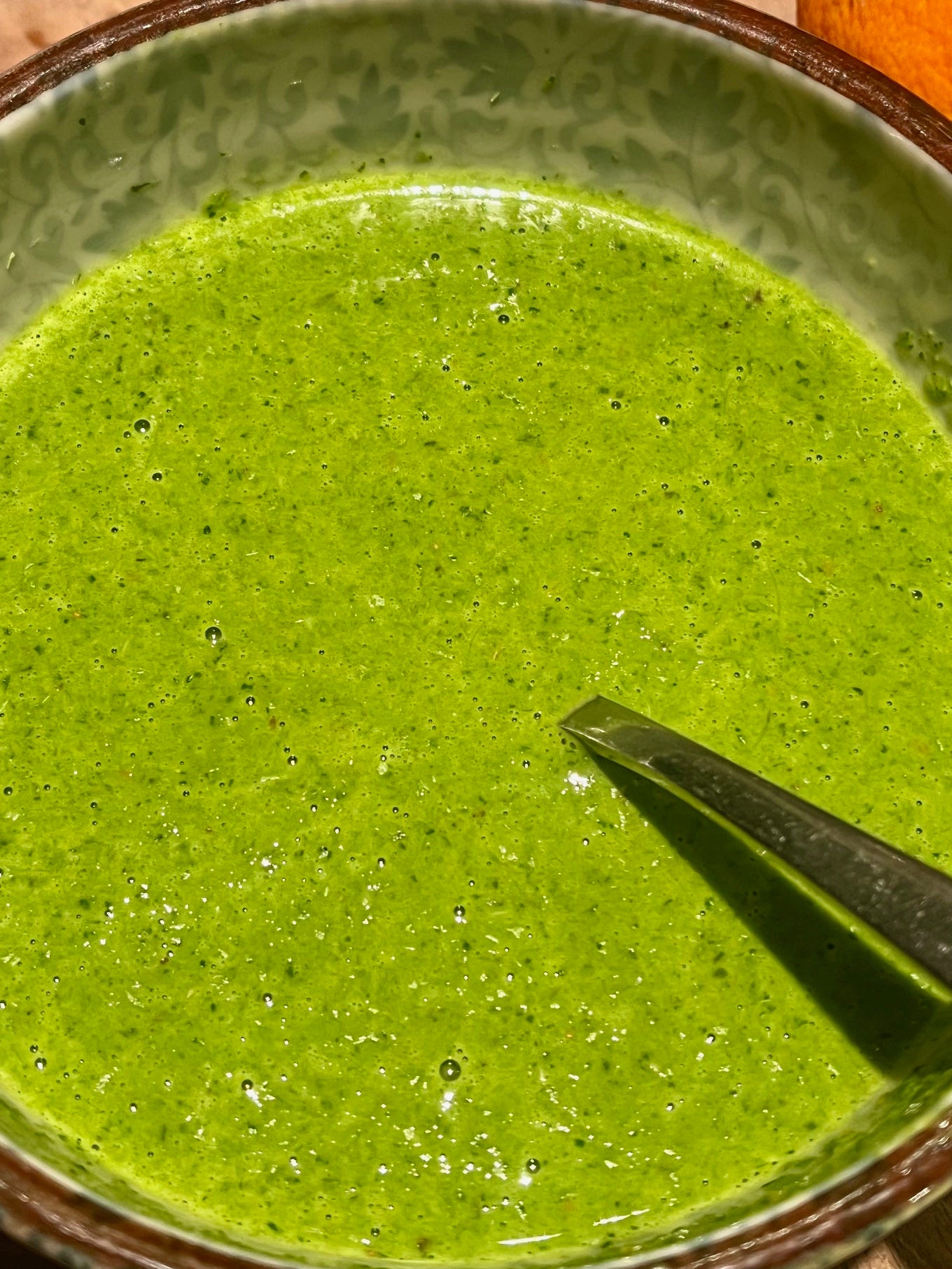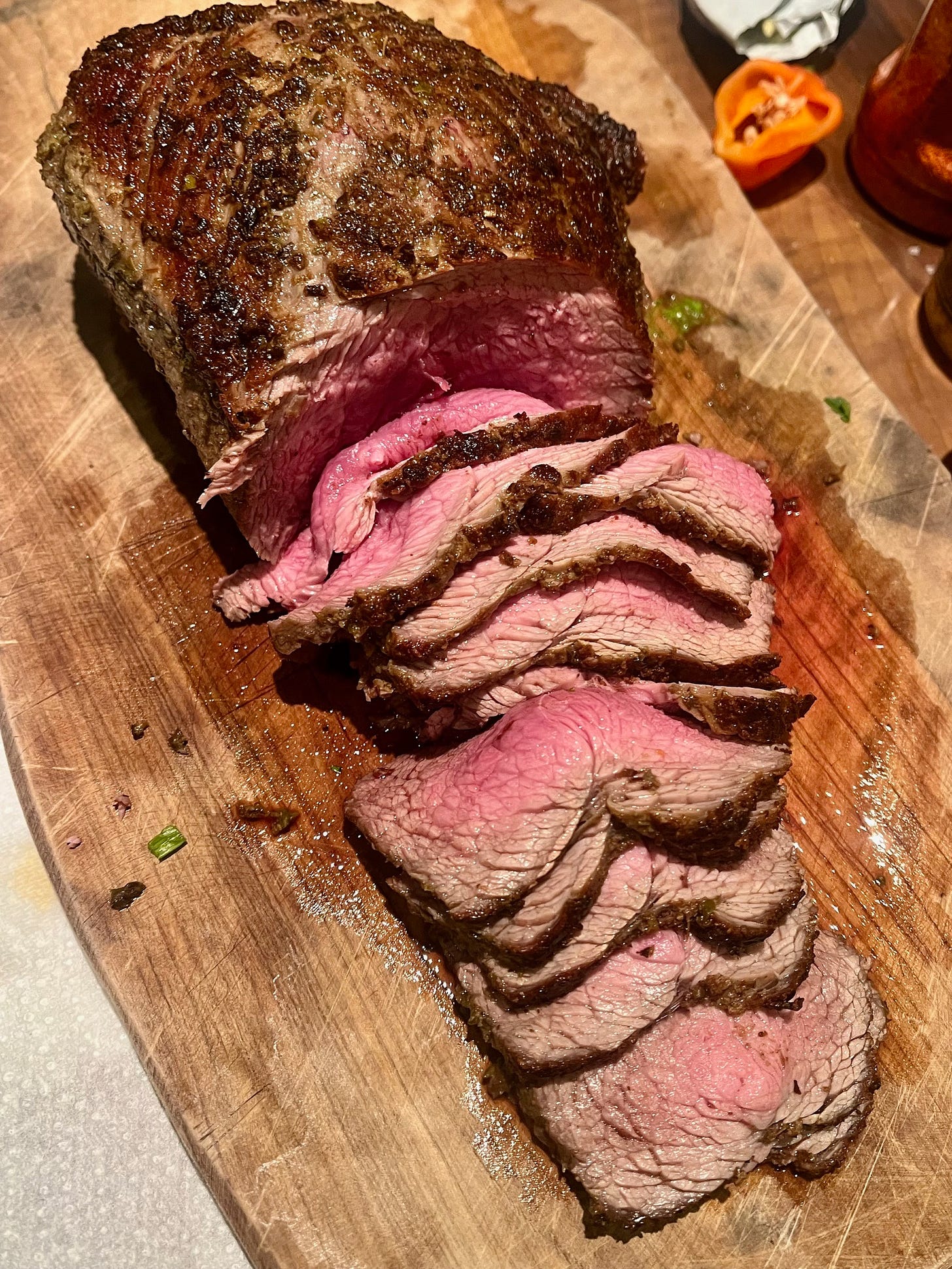As promised my second post of the week with pressure cooker versions of cooking methods not often associated with pressure cooking. This one has a paywall for the method as is usual for my Last Night’s Dinner posts. But those of you with my two most recent books on pressure cooking will know that the method for roasting can be found in both of them and there is plenty of info on how to cook in the preamble.
I don’t very often buy large chunks of beef and when I do it is usually cuts which need careful cooking to tenderise - shin, brisket or ox cheek - which can be used judiciously over several meals. I find I get much more from these because they will combine with other ingredients to make sauce and gravy which can then add goodness to all kinds of dishes. This tends to be the case with lamb, too. Just the other night I had some fall off the bone lamb shoulder left over from a Sunday lunch, as well as plenty of very rich gravy. Some of this rosemary and garlic rich gravy went into a Greek inspired poutine along with fried potatoes and halloumi (poutine possibilities are endless and I am going to write about it soon). The rest added depth to a chickpea, lamb and greens curry on another night. Plus cold cuts of course.
When we want steak, it is usually venison from the farmers’ market (sika out of preference), or what were traditionally the cheaper cuts - full of flavour, if tougher - onglet and bavette especially. But last weekend at the farmers market I found a cut I didn’t recognise and my curiosity won out. Of course I shortly fell into a frustration of confusing nomenclature. And I’m still not 100% what it was I bought. What I can be certain of, however, is that it was a cut that lends itself very well to pressure roasting.
The cut was labelled “Petite Shoulder”. The farmer told me to search for “Jewish fillet/tenderloin” as that would give me more results. (It actually didn’t yield much by way of recipes or information at all). He said that it was basically a whole piece of chump steak, so cut from the forequarter. This is why it is given the name Jewish fillet - forequarter is kosher, hindquarter isn’t and most cuts of steak come from the hind quarter. I have a feeling it is the same as flat iron/feather blade. In looks, the thicker end was very much like lean featherblade - has the seam intersecting it but not the marbling. The thinner end looked as lean as fillet, more like a tenderloin. It was much cheaper than any of the other cuts, by a long shot - this piece was £20. The same size in fillet was £99, with the sirloins, rumps, rib eyes falling half way in between.
In terms of cooking, I was told to either treat as brisket, so fall apart tender, or go fast - sear and then roast as a single piece for 25 mins or cut into steaks and grill/fry. I decided on the roast, but of course pressure roasted. This despite knowing it would cook unevenly due to the disparity in thickness. But this suited me fine. Shariq and I like roast beef to be well seared but rare, Adam prefers his medium rare. And this is exactly what we ended up with.
The method for pressure roasting is unbelievably simple. Sear as well as you can on all sides (it gets smoky, so extractor fan on, external door open) - and if you are using a sensitive electric cooker, use a frying pan instead. Then deglaze by adding a bit of liquid to the base (wine makes a good gravy), then put the meat on a trivet. Close the lid, bring up to high pressure and for a relatively thick piece of meat (10-12cm), cook for 3 minutes for rare, 4 for medium rare, 5 for medium. Then leave to drop pressure naturally, which also starts the resting process and you will find a lot of meat liquor drops below.
If I had been feeling less lazy, I would have made some sauteed potatoes to go with. Instead, we piled into flatbreads. Then Adam had steak and eggs for breakfast, I had a steak sandwich for lunch and Shariq ate a load more on its own, with about half a jar of horseradish. There is still a fair bit left.
Oh, and a note on the sauce. I was planning on a mojo (sour orange), but had bought big piles of herbs so then thought about chimmichurri, but as that needs time if done properly in the end I just made this up. It is a variation on a regular theme and a very good non marmalade way of using Seville oranges. If you don’t have Seville oranges, you can use a combination of orange and lime. Or just make a lime version, that will be equally as good. And if you really like sauces of this sort, if you add a bit more salt and put in a very clean jar, they will sit happily in the fridge for quite some time, very gently fermenting which adds depth of flavour. Good in all sorts of things, but I love over fried eggs or in cheese toasties.
Roast Beef with a Seville Orange Green Sauce
For the sauce:
3 pared strips of Seville orange, finely chopped
Juice of 1 Seville orange
1 small garlic clove
1 small Scotch bonnet, deseeded (or any fresh chilli you like)
Leaves from a sprig of thyme
A small bunch of coriander
A small bunch of parsley
1 tbsp wine or sherry vinegar
A pinch of sugar (optional)
3 tbsp olive oil
For the beef:
1 piece of roasting beef, cut up to you
1 tsp coarse black pepper
1 tsp dried oregano
1 tsp ground cumin
1/2 tsp ground cinnamon
1 tbsp olive oil
A little red wine (or water, or stock)
To serve:
A few salad leaves/micro greens/extra herbs
1 tbsp olive oil
1 tsp white balsamic vinegar or sherry vinegar
2 tsp sweet orange or clementine juice (optional, you can just make regular vinaigrette)
Flatbreads (or sauteed potatoes, or tortillas - this dish would make excellent tacos)
Keep reading with a 7-day free trial
Subscribe to Catherine is under pressure to keep reading this post and get 7 days of free access to the full post archives.





